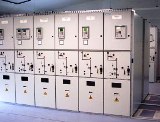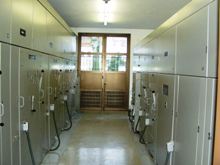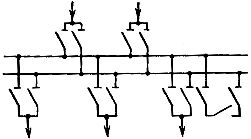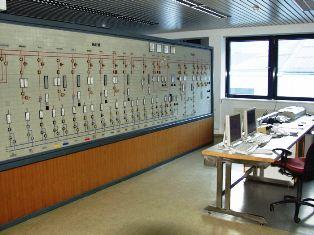Distribution busbars
 The need to interconnect power supply and output lines determines the use of stations, substations, switchgear and bus points.
The need to interconnect power supply and output lines determines the use of stations, substations, switchgear and bus points.
All generators or transformers, bushings and outgoing lines are connected to the busbars. Electrical energy is supplied to the busbars and distributed through them to individual output lines. Therefore, the busbars are the nodal point of the connection scheme through which all the power of the station, substation or distribution point flows... Damage or destruction of the busbars means interruption of the electricity supply to consumers. Therefore, the busbars are given serious attention in the design, installation and operation of electrical installations.
The simplest system is the so-called A single busbar system (Fig. 1) used in low-power electrical installations with a single power source.

Rice. 1. Single busbar system
At stations and substations that have two or more transformers or generators, in order to increase the reliability of the supply of electricity to consumers, the buses are split, that is, they are divided into two and sometimes more parts. An equal number of generators or transformers and outgoing lines must be connected to each section (Fig. 2).
Rice. 2. Single section busbar system with section disconnector
Splitting the bus provides the circuit with greater operational flexibility (when a bus section goes out of service, only part of the input and output lines are disconnected).

In the event of a transformer failure, it is switched off and the two sections are interconnected by a disconnector, having previously disconnected irresponsible consumers to prevent overloading.
It is also permissible to operate with the disconnector switched on to ensure even distribution of the load between the supply lines. In this case, in the event of an accident in one of the sections, the power supply to all consumers is interrupted for the time required to separate the sections. In the event of an automatic shutdown of one of the power sources, the second source will be overloaded during the time necessary to disconnect the irresponsible users.
In the presence of a crossed switch (Fig. 3), the latter can also be closed or opened during operation.

Rice. 3. Single section busbar system with section switch
When operating with the circuit breaker closed, it is equipped with overcurrent protection that automatically disconnects the damaged section. However, this solution is not recommended as it does not provide significant advantages over cross-sectional disconnector schemes.
The use of a cross-over switch is recommended only in cases where it is used to automatically switch on the backup power from another operating source and during normal operation of the electrical installation is in the open state.
If the substation has a single section busbar system, redundant outgoing lines must be connected to different busbar sections.
For greater reliability of the power supply and greater convenience in operational switching of large stations and substations, a double-bus system is used (fig. 4), which is allowed only if there is a suitable justification for each individual case.
Rice. 4. Double busbar system
During normal operation of an electrical installation, one bus system is operational and the other is standby. Both bus systems can be interconnected with a bus switch, which allows switching from one bus system to another without interruption of the power supply, and can also be used as a substitute for any of the switches of the electrical installation. In the latter case, the line from which the circuit breaker has been removed for repair is connected to the backup bus system, and the operating and backup bus systems are connected by a bus-connecting circuit breaker.



